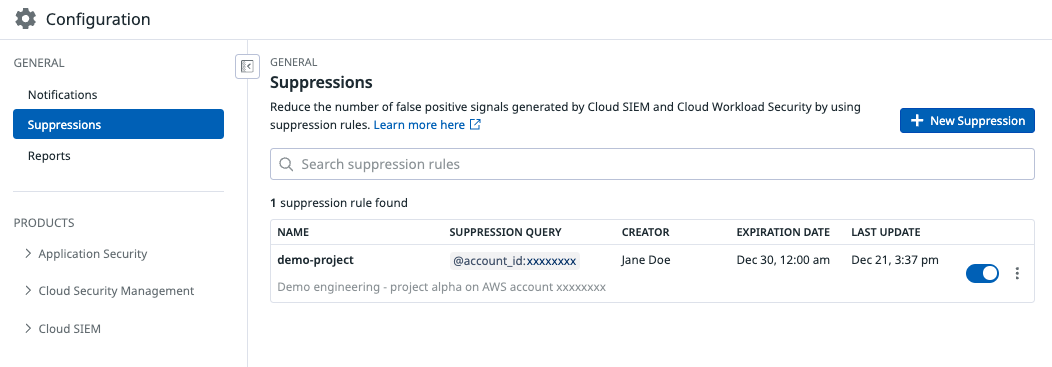- Essentials
- Getting Started
- Agent
- API
- APM Tracing
- Containers
- Dashboards
- Database Monitoring
- Datadog
- Datadog Site
- DevSecOps
- Incident Management
- Integrations
- Internal Developer Portal
- Logs
- Monitors
- OpenTelemetry
- Profiler
- Session Replay
- Security
- Serverless for AWS Lambda
- Software Delivery
- Synthetic Monitoring and Testing
- Tags
- Workflow Automation
- Learning Center
- Support
- Glossary
- Standard Attributes
- Guides
- Agent
- Integrations
- Developers
- Authorization
- DogStatsD
- Custom Checks
- Integrations
- Create an Agent-based Integration
- Create an API Integration
- Create a Log Pipeline
- Integration Assets Reference
- Build a Marketplace Offering
- Create a Tile
- Create an Integration Dashboard
- Create a Monitor Template
- Create a Cloud SIEM Detection Rule
- OAuth for Integrations
- Install Agent Integration Developer Tool
- Service Checks
- IDE Plugins
- Community
- Guides
- OpenTelemetry
- Administrator's Guide
- API
- Partners
- Datadog Mobile App
- DDSQL Reference
- CoScreen
- CoTerm
- Cloudcraft (Standalone)
- In The App
- Dashboards
- Notebooks
- DDSQL Editor
- Reference Tables
- Sheets
- Monitors and Alerting
- Metrics
- Watchdog
- Bits AI
- Internal Developer Portal
- Error Tracking
- Change Tracking
- Service Management
- Actions & Remediations
- Infrastructure
- Cloudcraft
- Resource Catalog
- Universal Service Monitoring
- Hosts
- Containers
- Processes
- Serverless
- Network Monitoring
- Cloud Cost
- Application Performance
- APM
- APM Terms and Concepts
- Application Instrumentation
- APM Metrics Collection
- Trace Pipeline Configuration
- Correlate Traces with Other Telemetry
- Trace Explorer
- Recommendations
- Code Origins for Spans
- Service Observability
- Endpoint Observability
- Dynamic Instrumentation
- Live Debugger
- Error Tracking
- Data Security
- Guides
- Troubleshooting
- Continuous Profiler
- Database Monitoring
- Agent Integration Overhead
- Setup Architectures
- Setting Up Postgres
- Setting Up MySQL
- Setting Up SQL Server
- Setting Up Oracle
- Setting Up Amazon DocumentDB
- Setting Up MongoDB
- Connecting DBM and Traces
- Data Collected
- Exploring Database Hosts
- Exploring Query Metrics
- Exploring Query Samples
- Exploring Database Schemas
- Exploring Recommendations
- Troubleshooting
- Guides
- Data Streams Monitoring
- Data Jobs Monitoring
- Data Observability
- Digital Experience
- Real User Monitoring
- Synthetic Testing and Monitoring
- Continuous Testing
- Product Analytics
- Software Delivery
- CI Visibility
- CD Visibility
- Deployment Gates
- Test Optimization
- Quality Gates
- DORA Metrics
- Security
- Security Overview
- Cloud SIEM
- Code Security
- Cloud Security
- App and API Protection
- Workload Protection
- Sensitive Data Scanner
- AI Observability
- Log Management
- Observability Pipelines
- Log Management
- Administration
Suppressions
Overview
Suppressions are specific conditions for when a signal should not be generated, which can improve the accuracy and relevance of the signals that are generated.
Suppression routes
You can set up a suppression query within an individual detection rule, or define a separate suppression rule to suppress signals across one or more detection rules.
Detection rules
When you create or modify a detection rule, you can define a suppression query to prevent a signal from getting generated. For example, add a rule query to determine when a detection rule triggers a security signal. You can also customize the suppression query to suppress signals for a specific attribute value.
Suppression rules
Use suppression rules to set general suppression conditions across multiple detection rules instead of setting up suppression conditions for each individual detection rule. For example, you can set up a suppression rule to suppress any signal that contains a specific IP.
Suppressions configuration
Suppression list
The suppression list provides a centralized and organized way for you to manage suppressions across multiple detection rules.
Create a suppression rule
- Navigate to the Suppressions page.
- Click + New Suppression.
- Enter a name for the suppression query.
- Add a description to provide context on why this suppression is being applied.
- Optionally, add an expiration date on which this suppression will be deactivated.
- Select the detection rules you want to apply this suppression to. You can select multiple detection rules.
- In the Add Suppression Query section, you have the option to enter suppression queries so that a signal is not generated when the values are met. For example, if a user
john.doeis triggering a signal, but their actions are benign and you no longer want signals triggered from this user, input the log query:@user.username:john.doe.Suppression rule queries are based on signal attributes. - Additionally, you can add a log exclusion query to exclude logs from being analyzed. These queries are based on log attributes. Note: The legacy suppression was based on log exclusion queries, but it is now included in the suppression rule’s Add a suppression query step.
Restrict edit permissions
By default, all users have view and edit access to suppressions. To use granular access controls to limit the roles that may edit a suppression rule:
- Click the vertical three-dot menu for the rule and select Permissions.
- Click Restrict Access. The dialog box updates to show that members of your organization have Viewer access by default. Use that dropdown menu to select one or more roles, teams, or users that may edit the suppression rule.
- Click Add.
- Click Save.
Note: To maintain your edit access to the rule, Datadog requires you to include at least one role that you are a member of before saving.
To restore access to a rule:
- Click the vertical three-dot menu for the rule and select Permissions.
- Click Restore Full Access.
- Click Save.
Further reading
Additional helpful documentation, links, and articles:



